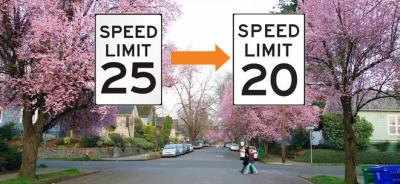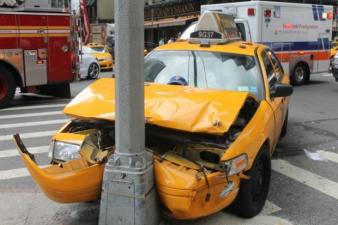Vacca Endorses Life-Saving 20 MPH Speed Limit

Speed kills, even when traffic is moving at New York’s citywide limit of 30 miles per hour. According to the UK Department for Transport, if a driver hits a pedestrian at 30 miles per hour, the victim only has a 55 percent chance of surviving. At 20 mph, the pedestrian has a 95 percent chance of survival.
With those ten miles per hour so often the difference between life and death, reducing the speed limit to 20 mph emerged as a top goal at last Friday’s Stop Speeding Summit, organized by Transportation Alternatives and NYU’s Rudin Center. After presentations about 20 mph programs from across the Atlantic and across the Hudson, City Council Transportation Committee Chair Jimmy Vacca capped the discussion by pledging his support for 20 mph speed limits in New York City.
“I’d like the speed limit to be 20 miles per hour,” said Vacca. A slower speed, he argued, is a necessary component of a transportation system that favors pedestrians and protects them from danger. “The pedestrian is always right, even when the pedestrian is wrong,” he said. He said that in his East Bronx district, speeding traffic is one of the top complaints.
Manhattan Borough President Scott Stringer stopped short of endorsing 20 mph limits outright, but suggested he was open to the idea. After expressing his concern about traffic ripping down Manhattan streets well above the 30 mph limit, Stringer noted that “perhaps it should be even slower.” He recalled learning about how increased speeds make crashes far deadlier. “It was really frightening to realize that these cars are coming at such a speed that if they hit somebody, they’re going to kill somebody.”
The next two speakers provided enough evidence to make many a fence-sitter come down on the side of lower speed limits.
First, British safety activist Rod King laid out why 20’s been plenty for the UK.
He highlighted the experience of Portsmouth, a city of 197,000 which implemented a 20 mph speed limit on every residential road. “Conventional wisdom before this said that if you reduce the speed limit and don’t put in physical barriers, people will almost totally ignore it,” said King. But on the faster-moving streets, he said, there was an average speed reduction of 7.4 mph. Casualties on the roads dropped by 22 percent overall, with large safety improvements for pedestrians and drivers alike.
It’s no wonder, therefore, that 20 mph speed limits are spreading like wildfire through the UK. There are now 5 million people living in towns where every single residential street has a 20 mph speed limit, said King. And the national Department for Transport has issued guidelines endorsing 20 mph limits for all residential streets.
Closer to home, New Yorkers can also draw inspiration from Hoboken, where the city just began a program urging drivers to stay below 20 mph. That educational campaign just won a vote of support from the City Council, whose largest complaint was that the speed limit was not changed outright, according to Hoboken Transportation and Parking Director Ian Sacs. (Sacs explained that state and county rules made that infeasible.)
Sacs did a test drive through Hoboken, following the 20 mph guideline, and found that it would add only 42 seconds to a trip across the small city. “I hope that doesn’t significantly impact your life to the extent that you wouldn’t want to save somebody else’s,” he said.
According to T.A. Safety Campaign Director Lindsey Ganson, New York City has the authority to reduce the speed limit to as low as 15 mph unilaterally around schools and in locations where some traffic calming measure is in place. State legislation would be required to reduce the overall city speed limit, and the legislature has allowed towns and cities to reduce speed limits before.

